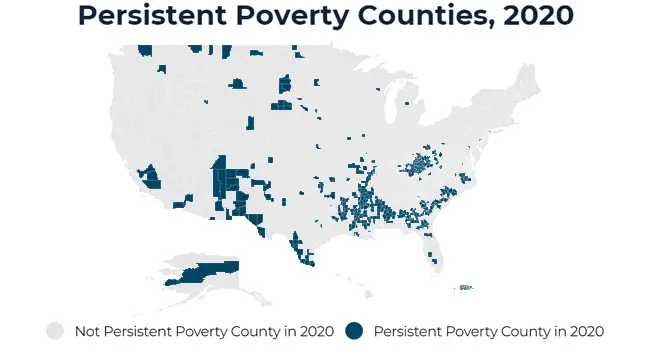When we think of places that have had high poverty for decades, they most often think of slum areas in big cities. But a new research brief from the Housing Assistance Council shows that rural counties make up the vast majority of places that have experienced extreme poverty over several decades.
HAC tabulated U.S. Census data to determine which counties were experiencing “persistent poverty.” The federal government defines persistent poverty counties as places that have had poverty rates higher than 20% over the last three decennial Census counts.
This means that at least one-in-five people in persistent poverty counties live in poverty, and that this has been the case for at least 30 years.
HAC found 377 persistent poverty counties in the U.S. in 2020, the year of the most recent Census. Of these, 307 are rural counties outside of metropolitan areas. Rural counties, then, are 81% of all persistent poverty counties.
Persistent poverty counties make up 10% of all U.S. counties and they take up 15% of the land area in the country. However, these high poverty communities are not spread evenly across the nation.
What areas are experiencing poverty?
Counties that have experienced persistent poverty are largely clustered in economically depressed rural areas. These regions also often have significant Black, Latino, or Native American populations. Their economies mostly depend on labor-intensive agriculture or extractive industries like mining and logging.
Regions where persistent poverty is concentrated include:
- Appalachia
- Rural Southeast
- Mississippi Delta region
- Southwest border region
- Tribal lands
- Agricultural regions
(such as Central Florida and California’s San Joaquin Valley)
HAC also calculated poverty rates for all 78 municipios in Puerto Rico. Municipios are the equivalent of counties on the U.S. mainland. All 78 of Puerto Rico’s municipios are persistent poverty counties.
While only 70 persistent poverty counties are in metropolitan areas, they have a larger number of people living below poverty. There are 4.6 million people living below the poverty line in all persistent poverty counties, with 1.7 million of these people living in rural areas. A few dense urban counties, like Bronx County in New York, account for the larger share of poor residents in metropolitan persistent poverty counties.
HAC’s research does show some good news. The number of persistent poverty counties declined from Number of PPC declined from 2010 to 2020. While there were 433 persistent poverty counties in 2010, the number fell to 377 in 2020.
Looking at where poverty has been concentrated over time shows us that desperate need is not confined to urban slums. We forget that many of the people who grow our food, harvest the timber to build our homes, and dig the minerals that power our industry have lived in poverty for generations.


